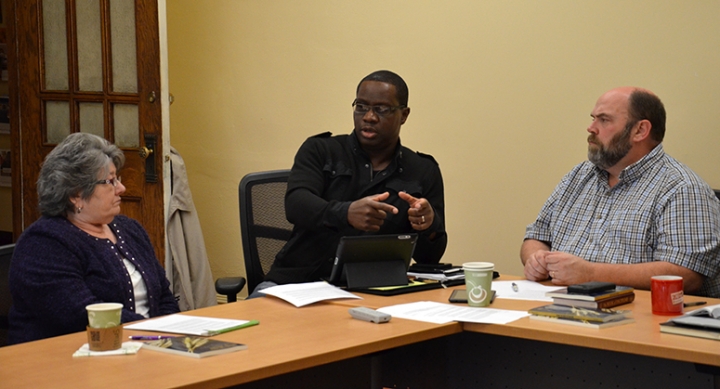news article

Conference Leadership Team looks at outcomes
October 30, 2014 / By Steve Hustedt / .(JavaScript must be enabled to view this email address)
The Conference Leadership Team (CLT) began its fall work by watching the video How Wolves Change Rivers. The video tells the story of the dramatic changes that occurred from reintroducing wolves into Yellowstone National Park in 1995.
The introduction of a small number of wolves changed the behavior of deer and other species, which allowed vegetation to grow along rivers, more species to thrive, and new ecological niches to emerge. Eventually, the introduction of those few wolves resulted dramatic changes to how the rivers themselves flowed.
“The learning the video provides, based upon the new realities the wolves introduction into Yellowstone National Park, speaks powerfully to the potential of our Conference Leadership Team,” said the Rev. John Martin, pastor at the Adirondack Community Church in Lake Placid and a new member of the CLT. “While the wolves did not have direct contact with the rivers, the vegetation and the aquatic life, their presence positively impacted all three.”
The video was used as in introduction to a new direction for the CLT as it transitioned to an operational team that focusses primarily on outcomes. Operational teams are:
- Adaptive in their work
- Small (three-12 members)
- Ongoing and organic
- Regularly learning together
- Meeting at least eight hours per month
Further, the CLT is the connecting team of the Conference. There was agreement among those gathered that they have not always functioned as an operational team, but that it would be the best way for them to function going forward.
“The Conference Leadership Team serves as the executive body that helps the system of the Annual Conference to engage, equip and empower local churches to be in ministry, encourage and develop transformational leaders, and build relationships with our neighbors,” said CLT member Bethany Printup-Davis. “As the CLT, we have the opportunity to introduce change into our environment. Like the wolves, are there people or ideas that have been absent or not introduced for 70 years? Can the good, bad, or indifferent realities be acknowledged and united by our love for Christ? Just as it was strategically planned and focused to reintroduce wolves back into Yellowstone, there must be a plan to nourish our Conference mission and ministries ... and in order to do that, we need to help leaders shape actual outcomes that require clear strategies to move toward identifiable and measureable changes.”
With the vision cast, the CLT began looking at the difference between intentions, priorities, and outcomes.
“An outcome is a clear and measurable difference that, if accomplished, will align with the identified priority and produce an intentional change that will move the Church another step closer to accomplishing the missional intention,” Bishop Mark J. Webb shared. “Our work is to help leaders (the Conference) shape actual outcomes, which require clear strategies to move toward identifiable and measurable changes. The work of outcomes is where the rubber finally meets the road.”
The CLT then divided up the work of looking at the outcomes stated in the Conference Mission Map with a critical eye. The Mission Map was introduced at Annual Conference a strategic plan for the future. With examination the CLT agreed that the outcomes needed to be refined and in some cases changed. The work of refining the outcomes began that day, but will continue in small group settings, at the next meeting, and throughout the year.
The second fall meeting of the CLT was a joint meeting with the Extended Cabinet. Those gathered continued the work started at the first meeting of the fall, going deeper into the idea of what the “wolves” might be for the Upper New York Conference. A model was introduced suggesting the one thing that needed to be introduced more than anything else was Christian leaders. The harder work would follow that meeting as both the Extended Cabinet and the CLT would look at how to discover, develop and deploy leaders so that they might be able to make disciples for the transformation of the world.
“We don’t know where the Spirit is leading us yet, but we know it’s the start of something big,” said Bishop Webb. “Just as people tried to stop the introduction of the wolves in Yellowstone because they feared the unknown, people will try to stop change in our Conference. But we are not a people of fear. We are a people of faith. God has big plans for us!”
Above Conference Leadership Team members, from left, Commission on Religion and Race representative Barbara Heise, Conference Lay Leader Scott Johnson, and the Rev. Bill Mudge, Adirondack District Superintendent. Photo by Christian Vischi.